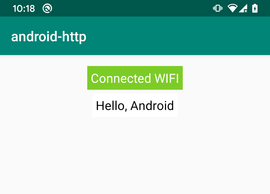Android | Connecting to the Network Using HttpUrlConnection

One common task for most Android apps is connecting to the Internet. Most network-connected Android apps use HTTP to send and receive data. This article shows you how to write a simple application that connects to the Internet, send HTTP GET request & display the response.
Objectives
- How to send HTTP GET request to a web server and display the response?
- How to check network connection?
- How to use AsyncTask to perform network operations on a separate thread?
Environment & Tools
Tools used in this post
- Android Studio 3.5
- Google Pixel 3
- Kotlin
- http://hmkcode-api.appspot.com/rest/api/hello/[NAME] this URL will return simple string “Hello, [NAME]”
About this Sample App
We will build an app that send HTTP GET request and display the response.
( 1 ) Create new Android Project
- Project Name: android-http
- Package Name: com.hmkcode.http
- Minimum SDK: API 19: Android 4.4 (KitKat)
( 2 ) Add Permissions
- Add the following two lines to the
AndroidMainifest.xmlfile
<uses-permission android:name="android.permission.INTERNET" />
<uses-permission android:name="android.permission.ACCESS_NETWORK_STATE" />
Starting with Android 9 (API level 28), cleartext support is disabled by default.
<application
...
android:usesCleartextTraffic="true"
...
</application>
( 2 ) Design App Layout
- Add two TextView to
activity_main.xml. - First TextView for displaying network connection info.
- Second TextView to display message from server.

<?xml version="1.0" encoding="utf-8"?>
<LinearLayout ...>
<TextView
android:id="@+id/tvIsConnected"
.../>
<TextView
android:id="@+id/tvResult"
.../>
</LinearLayout>
( 3 ) Check the Network Connection
- Before making any network operation you need to check if you are connected or not.
- To check whether a network connection is available use getActiveNetworkInfo() and isConnected().
private fun checkNetworkConnection(): Boolean {
val cm:ConnectivityManager =
getSystemService(Context.CONNECTIVITY_SERVICE) as ConnectivityManager
val networkInfo:NetworkInfo? = cm.activeNetworkInfo
val isConnected: Boolean = if(networkInfo != null) networkInfo.isConnected() else false
if(isConnected){
tvIsConnected.setText("Connected "+networkInfo?.typeName)
tvIsConnected.setBackgroundColor(0xFF7CCC26.toInt())
}else{
tvIsConnected.setText("Not Connected!")
tvIsConnected.setBackgroundColor(0xFFFF0000.toInt())
}
return isConnected;
}
( 4 ) Perform HTTP GET Request
- The simplest example for network operation is HTTP GET request.
- We create a new URL object by passing url string to the constructor.
- The URL object is used to establish an HttpURLConnection.
- Then, we execute the operation and receive the response as InputStream.
- Finally, we use helper method to convert InputStream to string.
private fun HttpGet(myURL: String?): String {
val inputStream:InputStream
val result:String
// create URL
val url:URL = URL(myURL)
// create HttpURLConnection
val conn:HttpURLConnection = url.openConnection() as HttpURLConnection
// make GET request to the given URL
conn.connect()
// receive response as inputStream
inputStream = conn.inputStream
// convert inputstream to string
if(inputStream != null)
result = convertInputStreamToString(inputStream)
else
result = "Did not work!"
return result
}
( 5 ) Perform Network Operations on a Separate Thread
- Network operation should always run on a seperate thread to avoid UI freeze.
- The AsyncTask class provides one of the simplest ways to create separate thread from the UI thread.
- Create an inner class extending AsyncTask.
- Override doInBackground() & onPostExecute.
inner class HTTPAsyncTask : AsyncTask<String, Void, String>() {
override fun doInBackground(vararg urls: String?): String {
return HttpGet(urls[0])
}
override fun onPostExecute(result: String?) {
tvResult.setText(result)
}
}
( 6 ) Convert the InputStream to a String
- We will use a helper method to convert InputStream byte into String
private fun convertInputStreamToString(inputStream: InputStream): String {
val bufferedReader:BufferedReader? = BufferedReader(InputStreamReader(inputStream))
var line:String? = bufferedReader?.readLine()
var result:String = ""
while (line != null) {
result += line
line = bufferedReader?.readLine()
}
inputStream.close()
return result
}